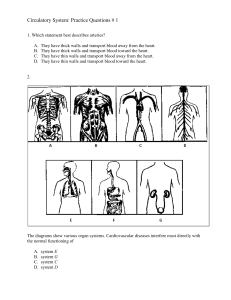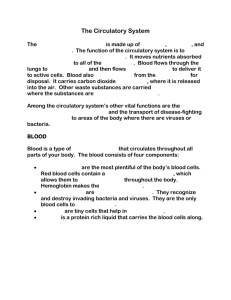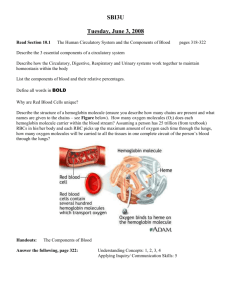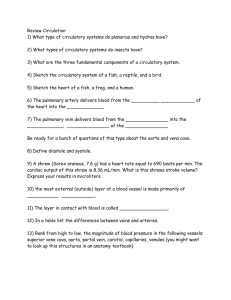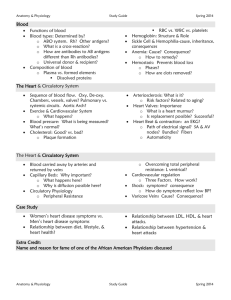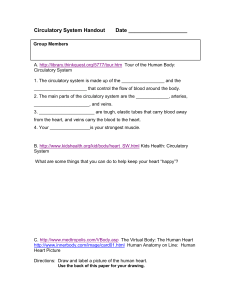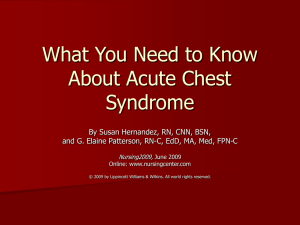Circulatory System: Practice Questions # 1
advertisement
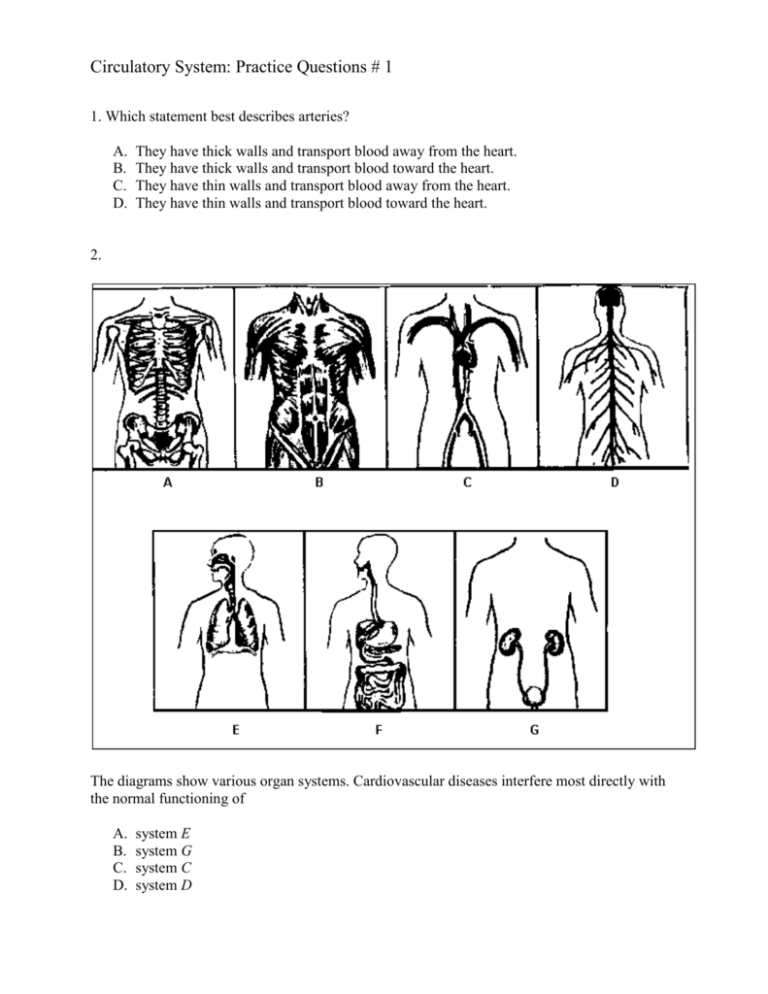
Circulatory System: Practice Questions # 1 1. Which statement best describes arteries? A. B. C. D. They have thick walls and transport blood away from the heart. They have thick walls and transport blood toward the heart. They have thin walls and transport blood away from the heart. They have thin walls and transport blood toward the heart. 2. The diagrams show various organ systems. Cardiovascular diseases interfere most directly with the normal functioning of A. B. C. D. system E system G system C system D 3. Blood normally flows from the capillaries directly into A. B. C. D. small arteries small veins lymph vessels heart atria 4. Which body structures have walls one cell thick? A. B. C. D. veins and arteries trachea and bronchi capillaries and alveoli lymph vessels and stomach 5. What is a major difference between red blood cells and white blood cells? A. B. C. D. Red blood cells contain hemoglobin, but white blood cells do not. Red blood cells can move, but white blood cells cannot. Red blood cells contain nuclei, but white blood cells do not. Red blood cells engulf foreign bacteria, but white blood cells do not. 6. Which organic compounds are needed for the synthesis of the plasma membrane, contain a large amount of stored energy, and have been linked to cardiovascular diseases? A. B. C. D. complex carbohydrates saturated fats simple sugars polyunsaturated fats 7. A pulse can be detected most easily in A. B. C. D. an artery a vein a capillary a lacteal 8. In the diagram of the human heart, which structures are most closely associated with the transport of deoxygenated blood? A. B. C. D. A, B, and C B, F , and I C, D, and E D, H, and I 9. The diagram represents several major circulatory pathways in the human body. Which sequence represents the normal blood flow in circulation to the lungs? A. B. C. D. 2→5→7→4 4→8→1→6 1→6→2→5 5→7→3→8 10. The breaking apart of platelets in the blood helps in the A. B. C. D. synthesis of hemoglobin formation of a clot release of antibodies deamination of amino acids 11. If a human system fails to function properly, what is the most likely result? A. B. C. D. a stable rate of metabolism a disturbance in homeostasis a change in the method of cellular respiration a change in the function of DNA 12. The main function of the human digestive system is to A. B. C. D. rid the body of cellular waste materials process organic molecules so they can enter cells break down glucose in order to release energy change amino acids into proteins and carbohydrates 13. Which two systems are most directly involved in providing molecules needed for the synthesis of fats in human cells? A. B. C. D. digestive and circulatory excretory and digestive immune and muscular reproductive and circulatory 14. Which body system is correctly paired with its function? A. B. C. D. excretory — produces antibodies to fight disease-causing organisms digestive — produces hormones for storage and insulation circulatory — transports materials for energy release in body cells respiratory — collects waste material for digestion 15. The failure to regulate the pH of the blood can affect the activity of A. B. C. D. enzymes that clot blood red blood cells that make antibodies chlorophyll that carries oxygen in the blood DNA that controls starch digestion in the blood 16. The sickle-cell trait is an inherited condition resulting from the presence of abnormal molecules of the protein hemoglobin in red blood cells. A person with the sickle-cell trait may have a child with the same condition because the child receives from the parent A. B. C. D. abnormal red blood cells abnormal hemoglobin molecules a code for the production of abnormal hemoglobin a code for the production of abnormal amino acids Answer Key 1: Circulatory System 1. A 2. C 3. B 4. C 5. A 6. B 7. A 8. B 9. C 10. B 11. B 12. B 13. A 14. C 15. A 16. C
